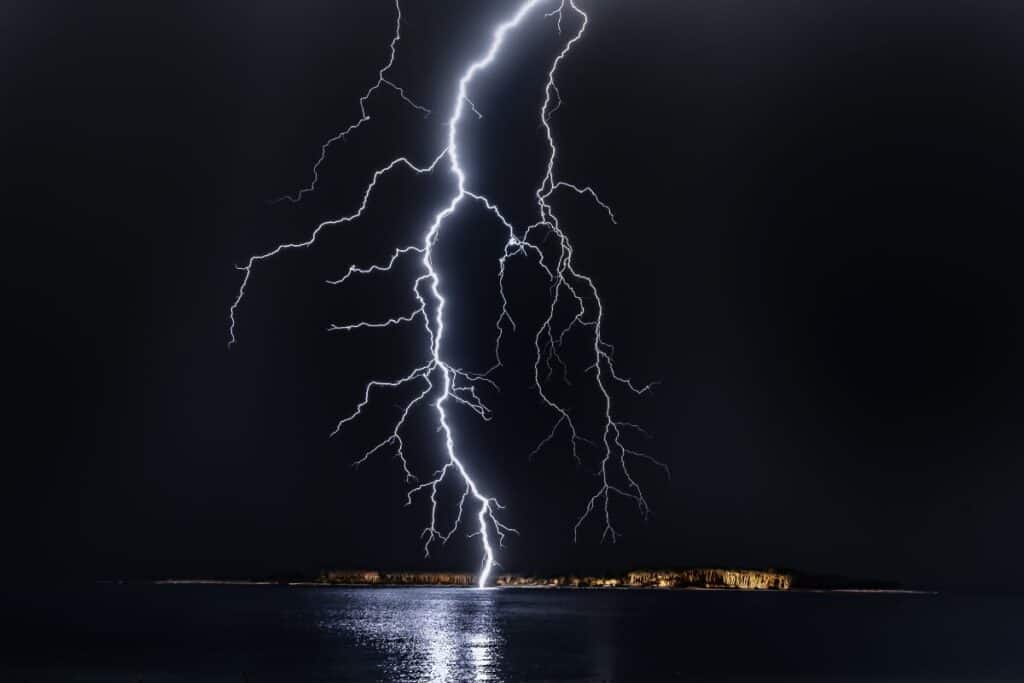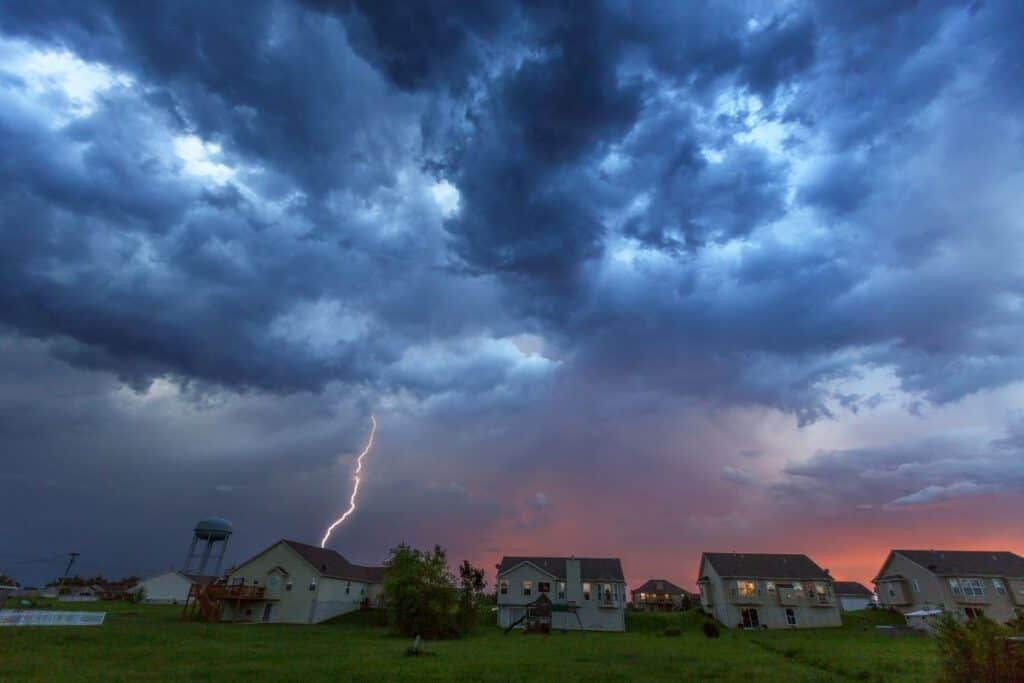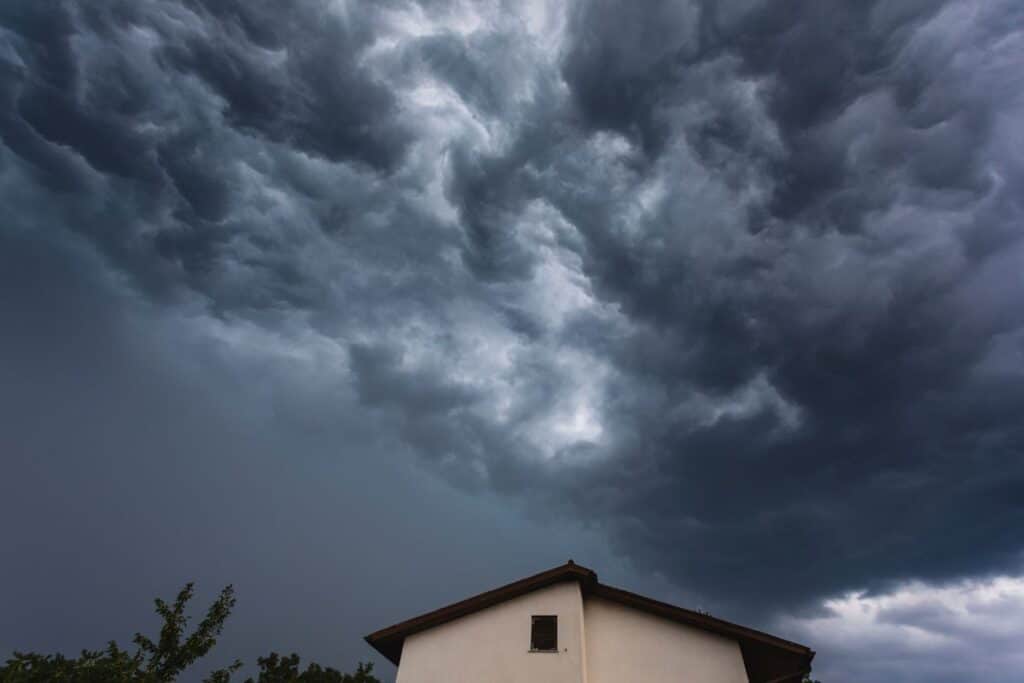We’ve all heard the adage about lightning never striking the same place twice. But how about solar panels? Do they increase the odds of a lightning strike to your home? Let’s bust the myths and bring you the truth in a flash of light.
Let’s clarify the connection between solar panels and lightning strikes.
Solar panels don’t attract lightning. Lightning is not drawn to specific objects, but rather, it seeks the easiest path to the ground. That said, any elevated structure, including a house with solar panels, could potentially provide that path.
Solar panels in themselves aren’t more prone to lightning strikes than any other part of your house.
However, the metal racking system that holds the panels might make your roof more appealing to lightning. This doesn’t necessarily mean your risk of a strike increases significantly, but it’s a factor to consider.

Do solar panels increase the risk of a lightning strike?
Even with this potential increased risk, homeowners with solar panels don’t need to fret excessively. Solar panel installations are designed with lightning protection in mind.
The systems are grounded, and they often include devices called surge protectors.
These are specifically engineered to protect your panels and your home’s electrical system from the voltage spikes that can occur during a lightning storm.
Grounding systems provide a direct, low-resistance path for the lightning to follow into the ground, bypassing your home’s electrical system.
Similarly, surge protectors help to absorb and divert the excess voltage caused by the lightning strike, protecting your solar panels and other appliances.
The risk can be further mitigated with a comprehensive lightning protection system.
These systems typically include a lightning rod or air terminal placed at the highest point of your home. This rod is connected via a conductor to a grounding rod driven into the earth.
The purpose of this system is to provide a direct path for the lightning, preventing it from passing through your home’s structure and causing damage.
In essence, while having solar panels may somewhat increase your home’s overall risk of a lightning strike due to their elevated and metallic nature, properly installed and grounded solar panel systems include safeguards to protect your home and the panels themselves.

If you live in a lightning-prone area, it’s wise to consult with a solar installation professional to ensure your solar panel installation includes comprehensive lightning protection.
While nothing can completely eliminate the risk of lightning, don’t let this natural phenomenon cloud your decision about installing solar panels.
With the right protective measures in place, you can harness the sun’s power while staying safe from nature’s electric display.
Let’s dig into those protection measures in a bit more detail now…
How To Protect Solar Panels from Lightning
If your area is prone to lightning storms, you might find yourself wondering how you can protect your solar panels from this powerful natural phenomenon.
You can protect your solar panels by making sure the system is installed correctly, using of surge protection devices, ensuring your solar system has an effective grounding strategy and making sure you have sufficient insurance coverage.
Solar panel systems, like other electronic equipment, can indeed be vulnerable to lightning strikes. However, effective measures can be put into place to significantly minimize the risk of damage.
The first line of defense is the installation of surge protection devices (SPDs).
SPDs are designed to limit transient overvoltages and divert surge current away from sensitive equipment, thus providing a basic level of protection against electrical surges caused by lightning.
They are typically installed in the electrical panel and at the inverter.
Another key element in safeguarding your solar system has an effective grounding strategy.
Grounding systems create a direct electrical connection to the earth, providing a path for electrical surges to be safely dissipated.
This is essential in managing the effects of lightning strikes and reducing the likelihood of damage to your solar panels.
In areas with high lightning activity, a lightning protection system (LPS) can be installed.
This system typically includes lightning rods (also known as air terminals) that attract lightning and safely guide it to the ground, bypassing the solar panels entirely.
Another step is ensuring your solar panels are insured. Homeowner’s insurance policies often cover solar panels, but it’s always wise to check with your insurer.
This way, even if a lightning strike does cause damage, you will be covered for the repair or replacement costs.
Lastly, proper installation and routine maintenance of your solar system are also vital in protecting your solar panels from lightning.
A well-installed solar system, performed by a professional installer, will have all the necessary precautions in place. Regular maintenance checks can also ensure that these protective measures are functioning as they should.
While the risk of lightning damage to solar panels cannot be entirely eliminated, a combination of surge protectors, grounding systems, possible lightning protection systems, insurance, and proper installation and maintenance can provide substantial protection.
Remember, an ounce of prevention is worth a pound of cure.
But what happens when lightning does strike your solar panels?
When Lightning Strikes: The Impact on Solar Panels
Sp you’ve taken all the precautions listed above, what exactly happens if lightning does hit your solar panels? Can they withstand the electrical surge? Let’s illuminate this topic.
When lightning hits a solar panel directly, it can cause significant damage. Solar panels consist of several small cells, and these can be fried by the intense surge of electricity. This could result in a decrease in the panel’s performance, or in some cases, total failure.
However, it’s important to remember that direct strikes are relatively rare, and even when they occur, there are measures in place to limit the damage.
As mentioned earlier, solar panel installations are often equipped with surge protectors and grounding systems designed to divert the excess electricity away from the panels and into the ground.
Surge protectors work by absorbing the excess voltage and safely redirecting it away from the solar panels.

Without this safety device, the large electrical surge could easily overwhelm and damage the panels, along with other electrical appliances in your home.
The grounding system also plays a crucial role in protecting your solar panels and home from a lightning strike.
By providing a low-resistance path to the ground, it ensures that the lightning’s electrical charge bypasses your home’s electrical system and panels, preventing potential damage.
If you live in an area with frequent lightning storms, it may be beneficial to have a full lightning protection system installed.
This would typically include a lightning rod or air terminal, which provides a safe and direct path for the lightning to reach the ground, further safeguarding your solar panels and home.
However, despite these precautions, it’s important to keep in mind that no system can provide 100% protection against lightning. In the event of a direct strike, there could still be damage.
That’s why many homeowners choose to include their solar panels in their home insurance policy, providing another layer of protection and peace of mind.
While a direct lightning strike can damage solar panels, the inclusion of surge protectors, grounding systems, and potentially a full lightning protection system, significantly mitigates this risk.
All that said, what about unplugging everything, would that help?
Should You Disconnect My Solar Panels and Inverter During Lightning?
Simply put, in most cases, you do not need to disconnect your solar panels and inverter during a lightning storm.
Solar power systems are designed to withstand various weather conditions, including storms. In fact, disconnecting the solar panels and inverter manually each time there’s a storm could be not only inconvenient but potentially hazardous.
However, solar panels and inverters aren’t entirely invincible.
If a direct lightning strike hits your solar system, it could indeed cause damage, despite the precautions in place. But remember, this occurrence is relatively rare, and your system is equipped with protective mechanisms to minimize such risks.
Most modern solar inverters are designed to disconnect automatically from the grid during a power surge or outage, which could occur during a severe lightning storm.
This feature, known as ‘anti-islanding,’ is a safety measure designed to protect utility workers from possible electrocution while repairing the grid.
Additionally, your solar system should have surge protection devices installed.
If your area is prone to severe lightning storms and you’re still concerned, you might consider installing a manual disconnect switch as an added layer of protection.
This switch would allow you to disconnect your solar system from the grid during extreme weather conditions.
While the idea of disconnecting your solar panels and inverter during a storm might seem like a prudent move, the protective systems in place are typically sufficient.
